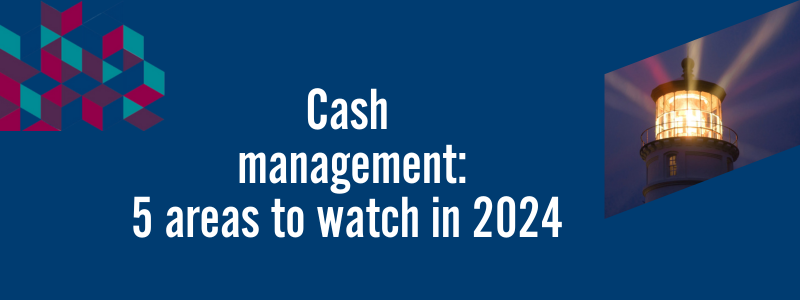

Current economic and geopolitical uncertainty is presenting treasurers with many challenges as they plan their cash management strategies for 2024. With positive news on inflation, the financial markets are now preparing for interest rate cuts. However, at the same time there are an unprecedented number of elections taking place this year – changes in administration could herald changes to economic policy, which in turn could create uncertainty and volatility in the financial markets.
All the while, there are other forces at play, such as the near-constant threat of cybercrime and fraud that require continuous monitoring. Alongside these challenges are the opportunities opened up by new technology that will allow increasingly sophisticated forecasting techniques to help guide treasurers.
Thus 2024 is looking like it will be another important year for cash management. Treasurers should be reviewing their approaches and adapting strategies to better accommodate future instability and unpredictability.
So, what should be on a treasurer’s cash management radar?
While businesses await news on interest rate cuts, treasurers are still looking for the most advantageous rates for investment returns or financing options. Market uncertainty and changes in yield curves make decisions on interest rate risk management more complicated. Timing could prove to be an important factor, so we could well see treasurers looking to lock in long-term rates for investment, and short-term rates for borrowing.
There is also the risk of ‘decoupling’ to consider, where different central banks adopt different approaches, creating a divergence in interest rates between separate economies.
A big development over the last year, and one that is set to continue into 2024, has been the rise of generative artificial intelligence (GenAI) – deepfakes are now a real risk for all businesses. As a consequence, treasurers will need to ensure they have robust processes in place to prevent and detect fraud – it could come in the form of malware or the impersonation of senior management, but either way, the availability of complex tools for criminal purposes is becoming cheaper and easier to access.
However, GenAI can also be used in the fight against fraud – increasingly sophisticated technology is now able to identify unusual, suspicious or unexpected transactions, often in real time, and help treasurers manage the potential material impact of fraud to their business.
This could be the year when new technologies such as GenAI really begin to revolutionise areas such as cash forecasting. Treasurers should be exploring how they can best utilise these new technologies, and other developments, to enhance visibility and gain more accurate, and ultimately more useful predictions.
Implementing new technologies won’t necessarily require a new treasury management system – the development of APIs will in many cases allow capabilities to be bolted on to existing systems, though most treasurers would be well advised to regularly review their tech stacks to ensure they continue to meet their cash management requirements.
Sustainability will continue to play an important role in cash management. Again, another ‘work in progress’, treasurers will be looking at where they can place their excess cash, and will turn to ratings agencies for guidance on the sustainability credentials of particular funds or undertake their own due diligence. Many funds in the EU dropped from their Article ‘9’ ESG classification to a ‘6’ and it is important that treasurers seek appropriate assurance.
While money market funds, which were subject to stress during the early stages of the COVID-19 pandemic, have been moving to improve their resilience, the Financial Conduct Authority is consulting on changes to regulation to increase the usable liquidity of money market funds. The proposals include a significant increase in the minimum proportion of highly liquid assets that all MMF types have to hold. This may have an impact on yields as opportunities to vary the duration of assets will be further constrained.
There have been a number of recent developments in the payments ‘journey’ – from the introduction of faster, or even instant, payment schemes through to continuing preparations for central bank digital currencies. The US Federal Reserve launched its US FedNow system in July last year, while the EU is making a push to increase the adoption of SEPA Instant, adding to the wide range of existing faster payment systems.
ISO 20022, the new global payments standard, continues to gain traction and will allow corporates far greater access to payments data than before. With the Bank of England and the European Central Banking switching last year without any hitches, corporates now have an increasingly sophisticated international payments ecosystem at their fingertips.
More generally, managing trade and cross-border payments effectively is vital to a business, so exploring alternative payment options that can offer fast and transparent settlement, competitive fees, exchange rates and even the opportunity to negotiate price based on settlement currency is incredibly important. Analysing payment data can also support negotiations with payment providers to provide more efficient and lower costs services.
These are just some of the areas that treasurers will need to monitor in the course of their cash management journeys. There are many other developments – cards, virtual bank accounts, reducing settlement times and counterparty risks to name but a few – that will also appear on the cash management radar.

Barclays Bank PLC is registered in England (Company No. 1026167) with its registered office at 1 Churchill Place, London E14 5HP. Barclays Bank PLC is authorised by the Prudential Regulation Authority, and regulated by the Financial Conduct Authority (Financial Services Register No.122702) and the Prudential Regulation Authority. Barclays is a trading name and trade mark of Barclays PLC and its subsidiaries. Find out about the Financial Services Register.
